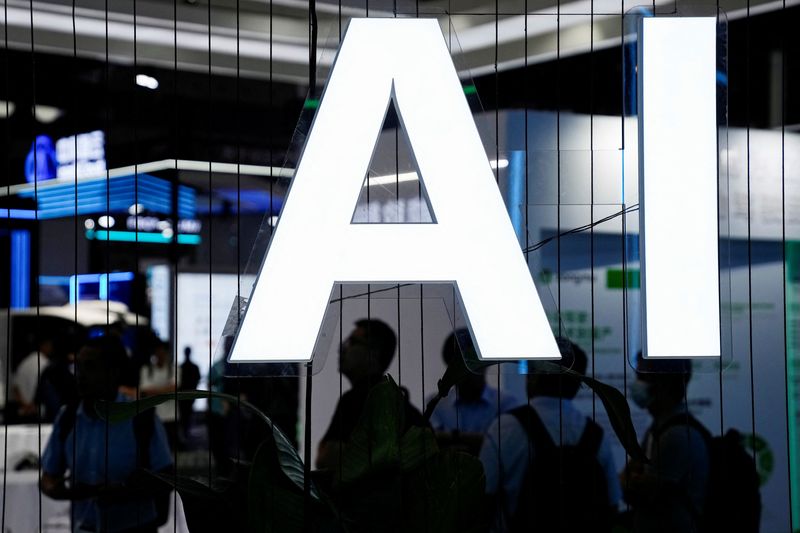(The opinions expressed here are those of the author, a portfolio manager at Fidelity International.)
By Taosha Wang
Tech investors are facing a new form of disruption. This investment cohort has historically paid little attention to macroeconomics, as ever-improving product features and innovative growth strategies have driven investment returns in high tech far more than things like aggregate growth and inflation. But artificial intelligence – and its enormous capital requirements – are ripping up this script.
The proposed spending on AI infrastructure by established tech companies in the coming years is eye-watering. In 2025 alone, big tech firms including Amazon (NASDAQ:AMZN), Microsoft (NASDAQ:MSFT), Alphabet (NASDAQ:GOOGL), Meta (NASDAQ:META) and Apple are projected to spend over $200 billion on capex – almost double what they shelled out in 2021, the year before the generative AI chatbot ChatGPT debuted. The increase in capex is almost entirely due to efforts to build out generative AI capabilities.
This highlights the key difference between the AI investment surge and the high-tech boom of the prior two decades: investment today is focused more on hardware than software – and hardware is obviously more capital-intensive.
If the economy slows and business prospects for these tech companies deteriorate, their executives will likely think twice about these ambitious – and entirely discretionary – spending plans. This complicates investors' calculations of the likely returns that can be expected from this nascent technology.
RISE OF THE MACHINES
In the first two decades of this century, software engineers disrupted one industry after another with business models that were nimble, scalable, and had low fixed costs. A small group of whip-smart entrepreneurs bootstrapped their start-ups, found quick success with early prototypes, and then made a series of strategic pivots. Think Amazon, Netflix (NASDAQ:NFLX), and many social media companies.
Fast forward to the age of generative AI, and the storyline has changed dramatically. The new business model typically revolves around very smart, complex and expensive machines that require a tremendous amount of energy to run and often take a long time to build.
For example, the Taiwanese semiconductor giant TSMC’s Arizona foundry cost $40 billion and commercial production won’t commence until 2025, four years after construction began.
Importantly, investment in AI is typically expected to take years to pay back. In the meantime, many factors could negatively impact the value of AI infrastructure, including concerns related to business confidence and cost inflation, as well as regulatory hurdles and geopolitical tensions that influence where companies can do business. This means tech investors can no longer easily ignore top-down concerns.
NEXT GENERATION
AI start-ups, unlike their counterparts in software, are also often very capital intensive, making them highly sensitive to market conditions and access to funding.
Most of these young companies rely on private capital, which many venture capitalists have been eager to supply in recent years. Investments in AI and machine learning, a related field, accounted for nearly half of all VC funding in the United States in the first half of 2024.
And these investments have often been enormous. In October, OpenAI raised $6.6 billion in equity capital from eight investors and another $4 billion in debt financing from nine lenders. The average size of these checks is over half a billion dollars.
Checks of this size can be written at a time when the S&P 500 is hitting new record highs, the U.S. economy is growing above trend, and inflation is heading downward. But what happens when the economy inevitably softens and public stock prices dip? Or what if the cost of capital in the U.S. remains elevated?
AI start-ups may then find it more challenging to fund their ambitious visions, which could, in turn, stall the pace of growth and innovation in the broad AI ecosystem. This, of course, could reduce demand for the AI infrastructure that big tech companies have invested hundreds of billions of dollars in.
CYCLE SHIFT
Hardware businesses also exhibit more cyclical characteristics than software. That's because they can't rely on continuous adjustments to meet shifts in customer demand, given the substantial inputs and manpower needed to create new products.
Consider that $3.5 trillion-plus chipmaker Nvidia (NASDAQ:NVDA) has now adopted a "one-year rhythm" for new products, doubling the speed from its previous product release cadence.
This means these companies are subject to traditional inventory cycles: when demand exceeds current supply, inventory is drawn down and prices rise, and vice versa. Hardware businesses, unlike nimble software companies, will thus struggle to scale their capacity up or down at short notice. So both the volumes and prices of hardware will typically fluctuate, subject to economic conditions.

It's notable that semiconductor sales have been positively correlated with manufacturing PMIs for decades. This relationship started breaking down in 2022 as AI euphoria really took off. If historical patterns hold, this could mean the boom in global semiconductor sales is overdue for a correction.
That’s just one example of why tech investors may need to become as macro-aware as the rest of the investment community.